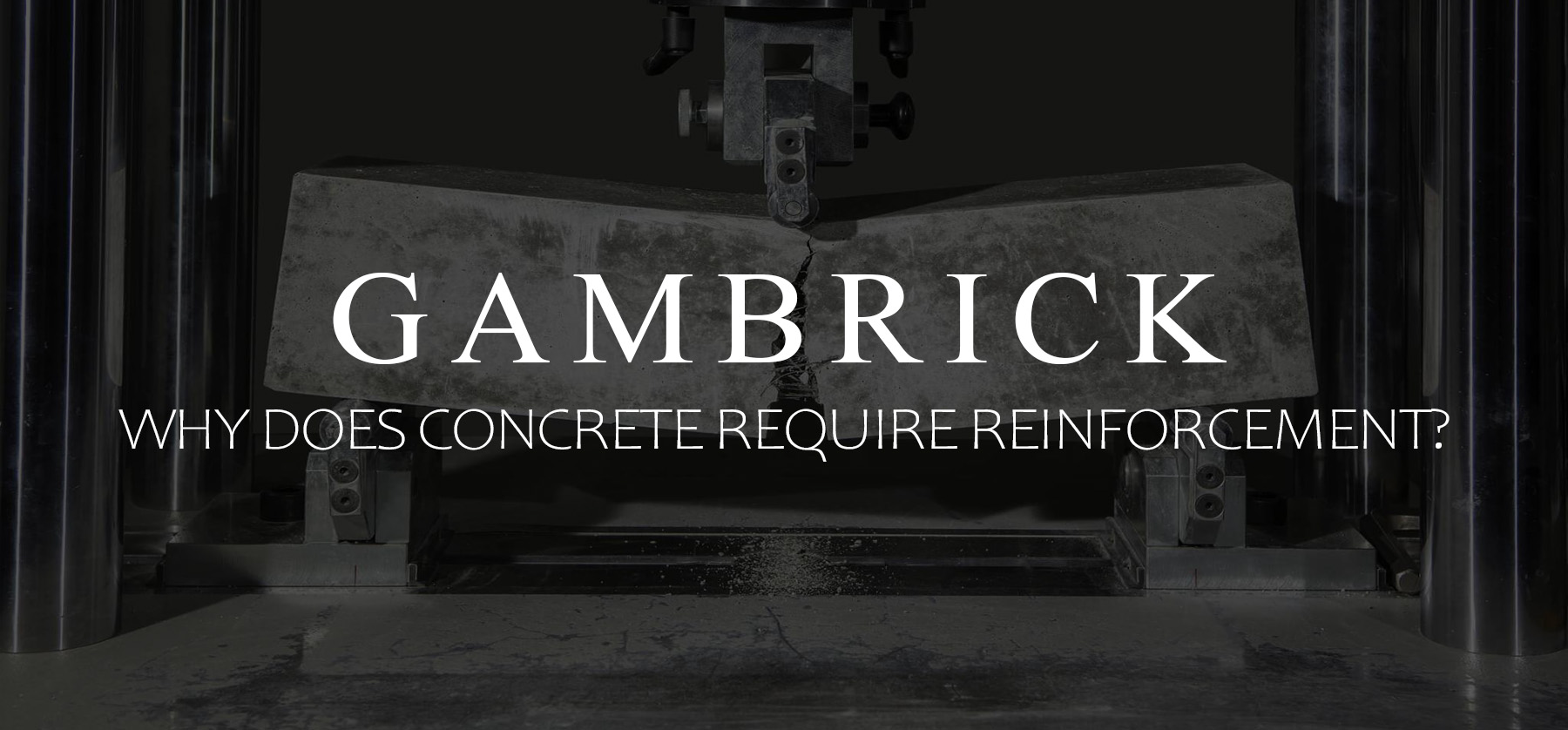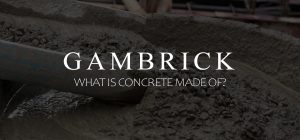
Why Does Concrete Require Reinforcement?
Concrete is a fantastic building material that’s used all over the world. It’s easy to make, affordable, durable and very strong. But for all it’s pros it has one very big con, tensile strength. Concrete has very high compressive strength, which means it can carry a lot of weight without cracking, but it’s tensile strength is very low. This make it prone to structural cracks and failures under certain types of stress. But when builders add reinforcement to concrete its weakness can be overcome. So why does concrete require reinforcement? To eliminate it’s naturally low tensile strength and prevent structural cracks.
It’s because of reinforcement materials like steel rebar that we can build huge concrete structures like buildings, bridges and dams. Even everyday things like a concrete driveway needs rebar to provide strength and crack resistance.
In addition to rebar, other forms of reinforcement, like chemical additives, wire mesh, fiber, micro-rebar, and mix adjustments can be used to strengthen the concrete.
Relief cuts, those lines in concrete slabs, also help prevent cracks be giving the slab room to move.
Almost all modern concrete structures use some sort of reinforcement. Whether it be fiber, micro rebar, wire mesh or steel, some type of reinforcement is probably inside every footing, wall, and slab. Even small finished concrete products like cast fireplace surrounds, countertops, planters and furniture use reinforcement to increase their tensile strength. Without it they would easily crack.
Concrete requires reinforcement to make it stronger. It adds strength and flexibility which helps overcome concrete’s natural weaknesses. Because of reinforcement materials we can build large scale structures like bridges, buildings and damns.
Ahead we’ll discuss why concrete requires reinforcement and which types are best.
Why Concrete Needs Reinforcement
Concrete needs reinforcement because regular concrete alone is weak in terms of tensile stress. This is the resistance of a material to breaking under tension. This tension includes twisting, stretching and/or bending. All things concrete structures are exposed to on a regular basis. For example, every time the wind blows concrete buildings are exposed to tensile forces.
Without reinforcement, regular concrete is vulnerable to cracks and possible collapse because it doesn’t have the strength to withstand tensile load all by itself.
All modern concrete structures include reinforcement. This includes the footings in your house, foundation walls and most slabs. Even small things like concrete countertops, fireplace surrounds, statues and planters use some form of reinforcement like wire mesh or fiber.
However it’s important to note that reinforcement is not required unless the concrete is used structurally. For example, by law you don’t have to use reinforcement inside your concrete countertops. But doing so would make them less prone to cracks.
Concrete Reinforcement Helps Handle Stress
Stress refers to the forces that constantly work against concrete. The strength of building materials like concrete is measured in terms of their resistance against common stresses like tension and compression. These are two very different types of stress that are both acting on concrete every single day.
It’s important to understand the differences between the two.
Compressive Strength
This is a pushing stress. Compression or compressive stress is applied towards the object and often results in a deformation by volume reduction. Concrete is very high in compressive strength which is why it can bear so much weight without compacting. This is measured in psi or pounds per square inch.
For example, 3500 psi concrete means it can withstand 3500 pounds of pressure, or compression, per square inch. The 3500 psi rating does not refer to the concrete’s tensile strength.
Concrete’s compressive strength is developed during the curing process. This is a chemical reaction between the cement and water which causes the production of calcium silicate minerals. The process generally lasts for about a month. However some large-scale projects take longer because of how much heat is created.
Concrete is a mixture of sand, stone and cement mixed with water. Cement and water are the active ingredients that cause curing. Sand gives concrete it’s grit and some strength. But its the stone that gives concrete it’s high compressive strength. The more stone you add the higher the concrete’s psi.
Tensile Strength
This is a pulling, twisting or bending stress. The technical definition of tensile strength is tension or tensile stress is the internal force exerted perpendicular to an object divided by its unit area. The direction of tensile stress is always away from the object, so the subject commonly results in an increase in length upon deformation.
Concrete isn’t strong enough to withstand large amounts of tensile stress by itself. Its natural tensile strength is only around 10-12% of its compressive strength. This is far too low to use it as a building material for large structures. It’s also very brittle and cracks easily. Because of these weaknesses, concrete requires reinforcement from other materials.
When concrete is being pulled apart, bent or twisted, it needs tensile strength to resist the stress. Unfortunately this is a natural weakness of concrete.
On it’s own, concrete has a very low tensile strength but a very high compressive strength. However builders add rebar and other reinforcements inside the concrete to conquer it’s weakness.
Structural engineers design the rebar that goes into concrete based on the stresses it will have to endure. This also takes into account movement in the soil, from wind or vibrations.
Concrete can become very strong when properly reinforced. But it usually shouldn’t be used as a structural material without some form of internal reinforcement like rebar.
Concrete Is A Composite Building Material
Because of it’s reliance on reinforcement, concrete can be considered a composite material. On it’s own it’s not generally strong enough to build with. But when you add steel and other reinforcements it can be used to build buildings, bridges and damns.
Without some type of reinforcement to increase concrete’s tensile strength, you can’t build much with it. You may assume that concrete can still be used on it’s own because of it’s high compressive strength, but you’d generally be wrong. Even solid concrete footings have rebar inside them to prevent cracking.
Rarely does a structural member experience just compression. In reality, almost all structures experience a mixture of stresses. The ground can shift which creates a void beneath a footing. Wind can blow a building from side to side creating lateral pressures. Vibrations can shake a building and it’s foundation. All of these things are considered forms of tensile stress. Without reinforcement, concrete may be able to handle the weight of the structure, but can still fail due to outside stresses.
Concrete alone does not make a good structural material. In the real world, there are just too many types of stress that it can’t resist by itself. To combat this, builders add reinforcement to improve concrete’s strength and overcome it’s inherent weaknesses.
Reinforcement within concrete creates a composite material. Concrete provides the compressive strength while reinforcement provides strength against tensile stresses.
Understanding Concrete
Concrete is made by mixing cement, sand and aggregate stone with water.
Water chemically reacts with cement which forms a paste that dries and hardens over time. This is called curing. Generally curing takes 28 days to complete.
During curing, concrete dries, heats up, hardens and grows very strong with a high compressive strength. But a very low tensile strength.
While cement and water are the active ingredients, sand and aggregate provide strength. Cement alone is weak and prone to cracks.
Concrete is a porous material that absorbs water. As concrete cures, internal water evaporates out which creates lots of small tubes throughout the structure. Water is easily absorbed into these tubes like a sponge. This is why concrete absorbs so much water and needs to be sealed.
While concrete’s structure gives it a lot of compressive strength, it has very low tensile strength. These internal tubes and pores can easily crack. Without the proper reinforcement, even a thick concrete beam supported at both ends has very little strength in the middle and can eventually crack under it’s own weight.
Concrete’s strength is measured in psi or pounds per square inch. This is a measurement of it’s compression strength. A 3500 psi bag of concrete can resist 3500 pounds per square inch without cracking. But this 3500 psi has nothing to do with it’s tensile strength.
The compressive strength of concrete can be adjusted by changing the type, size and amounts of it’s aggregate. However none of this will do much to alter it’s tensile strength. To increase concrete’s tensile strength you have to add reinforcement like rebar, wire mesh, fiber and/or chemicals.
Rebar is the most widely used form of concrete reinforcement. It’s found in just about every home, building and structure built out of concrete.
What Concrete Reinforcement Doesn’t Do
As a rule, reinforcement does not increase concrete’s compressive strength very much. It increases tensile strength. Adding rebar to 3000 psi concrete doesn’t add much psi.
Reinforcement has nothing to do with the amount of compression, or weight, the concrete can handle. To increase this you need other additives or a change in the mix. Generally adding additional psi requires using larger and/or more stones.
Chemical additives can also be used to increase concrete’s compressive strength.
Reinforced concrete helps prevent large cracks that can cause a structure to fail. But they don’t prevent all cracks. Small surface level cracks are normal and don’t necessarily weaken the concrete. When cracks do get deep, reinforcement helps keep them tight which may prevent concrete from breaking apart.
In addition to using concrete reinforcement, you should also make sure to do the following:
- Have a consistent slab thickness.
- Proper joint spacing.
- Take measures to resists shrinkage.
- Build a solid & level base.
- Cure the concrete properly.
- Use the correct concrete mix ratio.
- Don’t use too much water.
- Control the concrete’s temperature it cures.
Reinforcing materials are a must when building most concrete structures. But they’re only part of the plan. You also need the proper concrete mix, a solid base, and a good installation.
Concrete Requires Reinforcement To Build Large Structures
Why does concrete require reinforcement? Because it overcomes the inherent weakness of concrete which is a very low tensile strength. By adding reinforcement such as rebar, builders can add properties to a concrete structure that makes it able to withstand outside forces. And these forces are very common such as shifting earth, vibration or wind.
We need concrete reinforcement to build all sorts of stuff. Bridges, dams, homes and buildings all need reinforcement. And so do small scale projects like concrete countertops, cast fireplace surrounds, furniture, statues or planters. Concrete alone is generally not a great building material because it’s very easy to crack. But adding reinforcement lets us make all sorts of cool products.
Although concrete has been used for centuries all over the world to build homes and buildings. Those structures were typically small or built in a way that overcame the concrete’s weaknesses. In other words, the designs were very limited. Most are simple square or box shapes. These days, we can do almost anything with concrete because we include the proper reinforcement.
Common Forms Of Concrete Reinforcement
There are quite a few types of concrete reinforcing materials on the market. The most common by far is steel rebar. It’s found in just about every concrete structural built in modern times.
You should choose a material that suites the project your working on and the stress your structure will have to endure. Obviously the type of stress placed on a bridge or building is very different from a countertop. Although the reason your adding reinforcement is generally the same just on a much smaller scale.
Steel Rebar
The primary purpose of rebar is to increase concrete’s tensile strength. This additional strength helps it resist cracking and compensates for it’s inherent weakness.
With greater tensile strength, concrete is able to resist breaking under tension which means it can safely span larger distances. It’s because of rebar that we have many of the bridges, dams and buildings you see today. Most large scale construction and residential structures wouldn’t be possible without steel rebar.
- Rebar provides additional tensile strength to a concrete structure. It helps distribute weight and tie the structure together which prevents cracks and structural damage.
- It helps stabilize concrete structures that move due to wind, vibration of shifting soil.
- Helps hold together brittle and/or cracked concrete
- Steel rebar helps with thermal stress. Concrete and steel have relatively similar thermal expansion coefficients which means they expand and contract at the same rate under thermal stress.
- Concrete’s tensile strength is only 10-12% of its compressive strength.
Concrete by itself is a very strong and durable building material. It’s been used all over the world to build structures for centuries. But those structures had big limitations until rebar was invented. These days we can build just about anything out of concrete thanks to the inclusion of rebar.
Rebar also helps deal with expansion and contraction forces that occur naturally with changes in temperature. It helps hold a concrete structure together as it tries to expand and contract.
Rebar inside a concrete structure can be just as important as the concrete itself. When you see a concrete building, foundation, bridge or wall, know that inside is generally a well engineered rebar structure providing additional strength and support.
It’s rebar that makes most modern structures possible.
The learn more about rebar check out our article here.
Types Of Rebar
Almost all modern concrete structures use reinforcement in the form of steel rebar. But rebar comes in a few different forms. It’s important to use the right type of rebar for your project.
Deformed Steel Rebar
Deformed steel rebar is the most common type of steel reinforcement used in concrete. This is the standard concrete reinforcing material builders and mason’s use on almost every project. It has a ribbed outer edge which gives something for the concrete to grab onto. Because of the ribs it’s very hard to pull deformed steel rebar out of a slab.
- Deformed steel rebar provides flexibility, strength and something for the concrete to grip onto.
- Relatively cheap.
- Comes in a variety of thicknesses called gauges.
- Prone to rusting. However this isn’t a problem when it’s encased in solid concrete.
Deformed rebar ribs come in a variety of designs. These include crescent, herringbone, and spiral shapes. The best rib design to use depends on the type of concrete you’re working with and what you’re building.
Threaded Steel bar
If you need a really long length of rebar, two smaller deformed steel rebars are tied together to form a single long piece. This is called lap slicing. However, if you don;t want to lap slice your rebar you can use threaded steel rebar instead. It’s threaded on the end which gives two length of rebar a place to attach by mechanical means.
Fiber-Reinforced Polymer Bars
Fiber-reinforced polymer bars or FRP is reabr that’s been coated with a corrosive resistant material. Regular rebar is prone to rust. But FRP won’t.
The problem with FRP is the coating. It’s brittle and easily cracks. Once the coating cracks the protection it provides is gone. But as long as the coating remains intact and in good condition the rebar won’t corrode.
Because of how sensitive the coating is, FRP loses some of rebars flexibility. If you bend or stretch it too much the coating can crack.
FRP is a lot more expensive than regular rebar.
Unless a blueprint specifically calls for FRP I don’t use it.
Fibers
Fibers can increase the strength of concrete.
Concrete reinforcement fibers are added into the concrete while it’s wet and being mixed. This helps ensure an even distribution of fibers throughout the concrete.
While fibers don’t increase concrete’s tensile strength as much as rebar, there’s still a benefit. And they can be used along side rebar for even more durability.
Fibers are very common in applications like slabs and sprayed concrete. When the concrete isn’t thick enough for rebar, fibers can help. They provide some strength without increasing the thickness of the structure.
Reinforcing fibers help prevent smaller hairline and shrinkage cracks. These are more for smaller projects like concrete countertops than large scale foundations. Although they can still be beneficial in large structures.
Micro Rebar
Micro rebar is a fairly new product that’s only been around for a few decades. It’s made of 1 inch steel that’s twisted to form small ridges. The micro rebar is added into the wet mix just like fiber but adds a lot more strength.
In some applications micro rebar is strong enough to replace traditional rebar.
When used in slabs, micro rebar can even be strong enough to eliminate the need for relief cuts. This can be a huge benefit when pouring an interior concrete floor. Concrete expands and contracts with variations in heat. Because of this, slabs needs joints to prevent cracking. But micro rebar can resist these pressures which eliminates the need for joints. It’s a much cleaner more consistent look.
Wire Mesh
Wire mesh comes in sheets made from thin wire that’s been welded together to form a grid. Sheets of wire mesh are tied together and placed inside the slab.
The strength gain from wire mesh is less than rebar and micro rebar but more than fiber. However you can wire mesh along side other reinforcements like fiber, rebar, micro-rebar and chemicals.
Wire mesh is very common inside thin slabs where there isn’t enough thickness for rebar. It’s cheaper and requires less labor than rebar because it comes in large sheets. Sheets simple need to be cut to size and tied together. It’s a fast and easy process.
Make sure when using wire mesh that you place it in the center of the slab. For example, place it 2 inches deep in a 4 inch slab. This is the typical thickness of sidewalks and patios. If you place it too close to the surface and not in the center your slab won’t be reinforced properly and could crack.
Does All Concrete Need Reinforcing?
No, not all concrete needs reinforcing. Large structural projects and slabs typically need steel reinforcement to provide support, flexibility and extra strength. Wired mesh can also help resist cracking. However, not every concrete project needs the extra reinforcement.
When you’re working on a large project, it’s important to carefully examine and understand the structural plans and building requirements. The type of rebar you need along with the size and how it’s to be used will be detailed on the structural pages of your blueprints. These are usually indicated by the letter S.
I generally use some form of reinforcement even on small scale projects that don’t necessarily need them. Concrete is brittle and prone to cracking so it’s a good idea to use it. These include things like fireplace surrounds, countertops, planters, stepping stones and small slabs. A little fiber, wire mesh or thin rebar goes a long way.
Will Concrete Crack Without Rebar?
Concrete can crack with or without rebar reinforcement. However it’s much less likely for concrete with rebar to crack and the cracks are usually less severe. In case of a crack, rebar can sometimes hold a footing or foundation together.
Cracks are manageable if they’re not that sever. Steel reinforcement can prevent the cracks from getting worse which gives you time to make repairs. In many cases rebar has prevented or delayed catastrophic building failure giving engineers time to make repairs.
Small cracks can occur with or without rebar. These are called hairline, spider or shrinkage cracks. They’re generally on the surface layer and not that serious. However you should still repair them to keep them from spreading.
Summary: Why Does Concrete Need Reinforcement
Concrete is a fantastic building material that’s used all over the world. It’s easy to make, affordable, durable and very strong. But for all it’s pros it has one very big con, tensile strength. Concrete has very high compressive strength. Which means it can carry a lot of weight without cracking. But it’s tensile strength is very low. This make it prone to structural cracks and failures under certain types of stress. But when builders add reinforcement to concrete its weakness can be overcome. So why does concrete require reinforcement? To eliminate it’s naturally low tensile strength and prevent structural cracks.
It’s because of reinforcement materials like steel rebar that we can build huge concrete structures like buildings, bridges and dams. In fact, almost all modern concrete structures use some sort of reinforcement. Whether it be fiber, micro rebar, wire mesh or steel, some type of reinforcement is probably inside every footing, wall, and slab. Even small finished concrete products like cast fireplace surrounds, countertops, planters and furniture use reinforcement to increase their tensile strength. Without it they would easily crack.
Concrete requires reinforcement to make it stronger. It adds strength and flexibility which helps overcome concrete’s natural weaknesses. Because of reinforcement materials we can build large scale structures like bridges, buildings and damns.
If you have any questions or comments about concrete reinforcement E-mail us any time.

John Mazzuca | About | More Posts |
Custom Home Builder
John Mazzuca is a custom home designer and builder at Gambrick with over 25 years experience in the construction industry. John has designed, built and/or remodeled hundreds of homes, small buildings, and commercial projects. He writes about business, real estate, home building, and household electronics. His work has been featured in Fox Business, Better Homes & Garden, House Beautiful, and more.




















